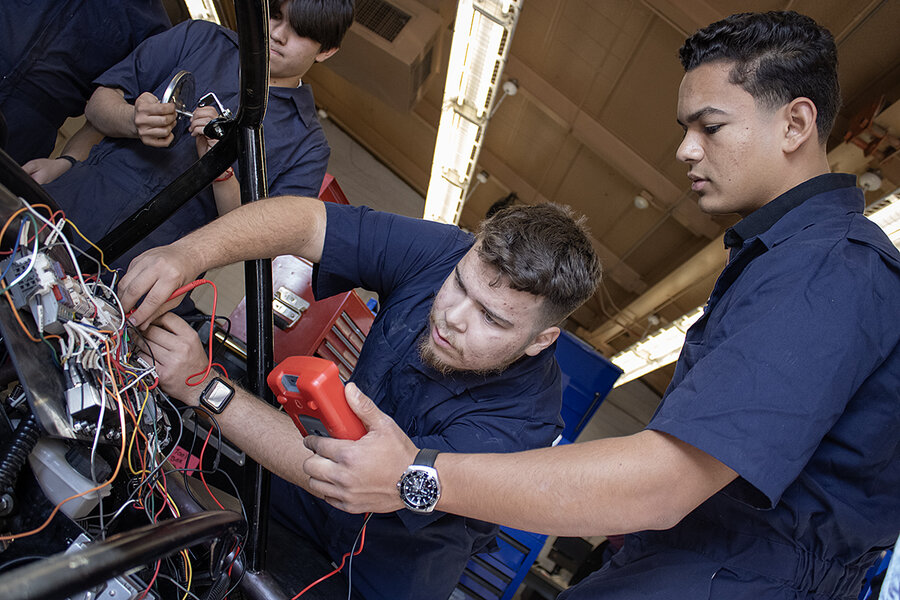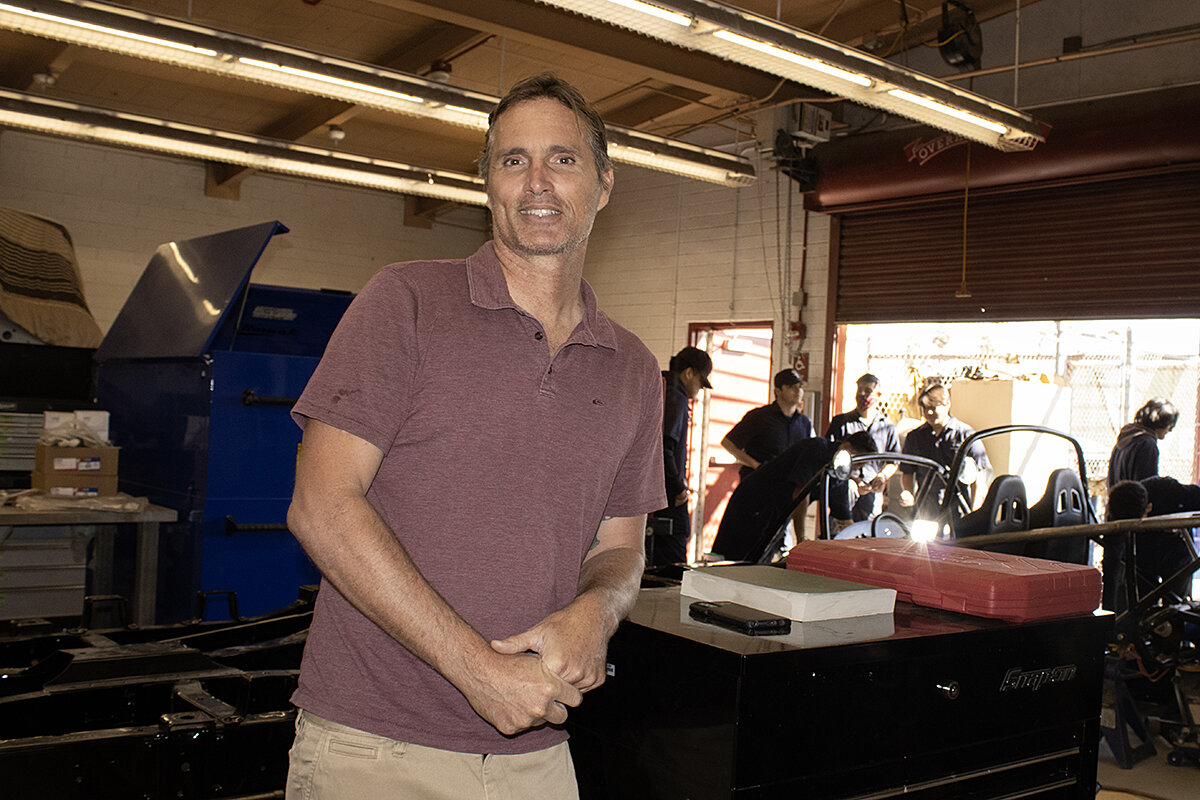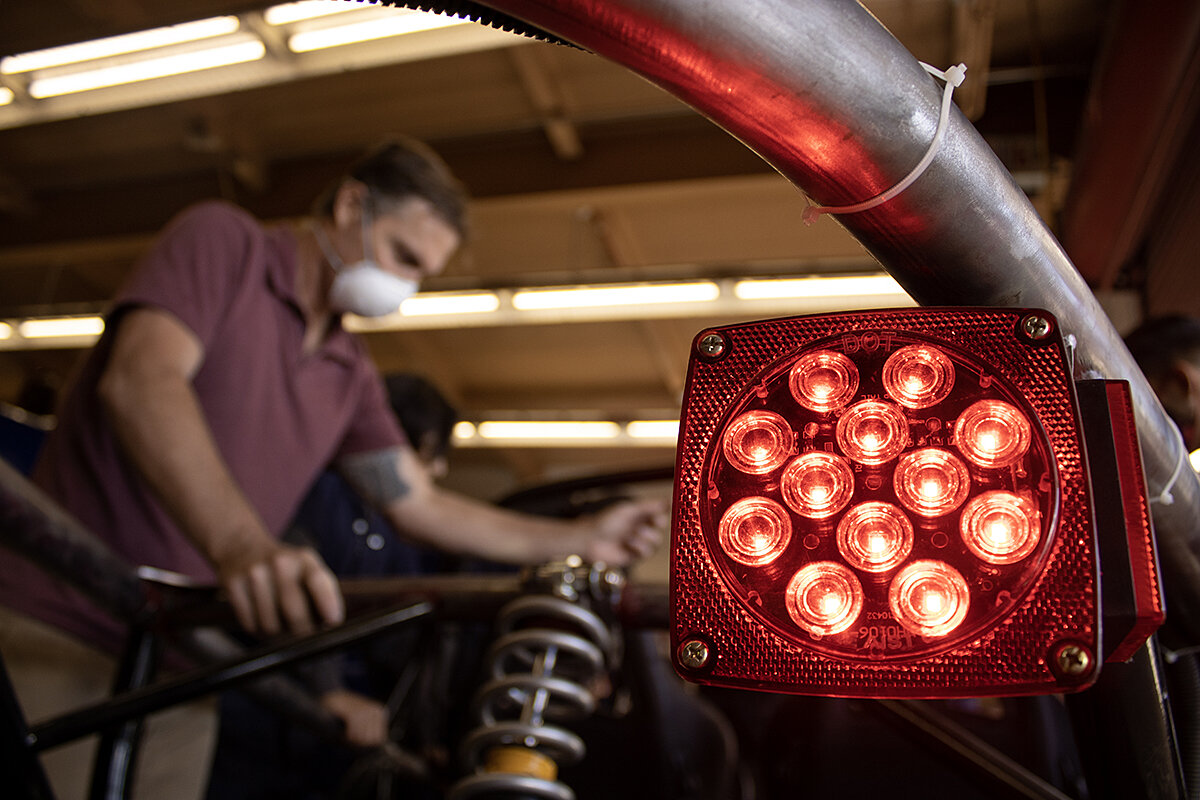These EV-savvy high schoolers could help California meet green tech goals
Loading...
| Calexico, Calif.
It’s a snake pit of wires, but the teens have it under control. Clad in navy coveralls, they’re checking voltage levels on a vehicle circuit board. Why won’t the right-side brake light work?
“We’re just trying to see, like, what the problem is,” says high school senior Nicholas Leon, focused on the multimeter in his grip.
The scene at Calexico High School, a mile north of the California-Mexico border, might resemble a typical auto shop class. Except when this car comes to life, it won’t spew fumes.
Why We Wrote This
A story focused onInnovation requires ingenuity. This border-town high school is revving up students for an EV workforce. It’s an effort well suited to California’s green technology goals.
It’s an electric vehicle – an EV – that runs on batteries.
The class complements the state’s vision of having all sales of new cars and light trucks be zero-emission vehicles by 2035. It’s part of a pilot project, funded by the California Energy Commission, to upskill students for a clean-energy workforce the state hopes to expand.
The need for EV-savvy autoworkers was implied in an announcement by Gov. Gavin Newsom on April 21. Two years ahead of schedule, the state has surpassed 1.5 million new zero-emission vehicle sales, though affordability and charging infrastructure issues remain. For California, zero-emission vehicles include battery electric, fuel cell electric, and plug-in hybrid vehicles, which, together, comprised nearly a fifth of all new cars sold here in 2022.
Several seniors in the class show an interest in EV-related careers, though the hands-on electrical and troubleshooting skills are useful tools no matter their path. Advocates hope that by training young talent for “green” jobs in the region, students will see themselves in the driver’s seat of local ingenuity and innovation.
“We have to be able to make sure that by the time they graduate and they choose their career path, that it’s here,” says Luis Olmedo, executive director of Comite Civico del Valle, an environmental justice group.
Historically, says Mr. Olmedo, students have wanted “to leave, because the only option is to go work in the fields” of Imperial Valley.
“We have to change that mindset,” he says. “There’s so much potential here.”
Preparing for the future
Calexico Unified School District sits in California’s arid southeast. Nearly all 8,300 students are Hispanic.
The city, with some 40,000 people, witnesses a mix of billion-dollar agriculture, rural poverty, and an international border that many drive across daily. Transportation, which contributes around half of the state’s greenhouse gas emissions, is one sector targeted to help California reach “carbon neutrality” by 2045, with EVs playing a critical role.
Auto shop teacher Keith Fisher says he’s preparing his students not only for possible work in the EV industry, but also for the know-how to maintain their own gasless cars. A day may come, he muses, when these students’ children may not even know what an internal combustion engine is.
“The technology is progressing so rapidly,” says Mr. Fisher. The longtime educator and surfer from Hawaii, who renovates old cars as a hobby, had to teach himself how EVs work.
“Once you can understand electricity and how it flows … it’s pretty straightforward,” he says.
The class assembles a two-seater sand rail, from the California company Switch Vehicles, that runs on batteries alone. A lead-acid battery pack that looks like a big, black brick sits in the front. Mr. Fisher is expecting to receive a lithium-ion EV, which is more common, from the state this year, along with a conversion kit and other resources. His auto shop curriculum has a two-year track: Juniors learn the basics, the EV comes in senior year. Students can earn credentials in both.
Trying not to get too far ahead of the curve
After a pandemic delay, this is the second fully in-person year students are working with an EV kit. The hands-on experience is a boon for Andrew Chong, who says the pandemic “really hit me hard” and canceled his plans to partake in a STEM competition.
“My future in EV is a future where there’s no disposable batteries,” the student says during a February class. “They’re not that good for the environment.”
These students “understand the environmental imperative. They understand the economic return for a career in this space. And they’re not just limited to the occupations of service maintenance,” says Larry Rillera, an air pollution specialist at the California Energy Commission.
Since 2017, his agency has spent $3.5 million for the Zero Emissions Vehicle High School Pilot Project, working in collaboration with the Advanced Transportation and Logistics Center at Cerritos College in Los Angeles County. The funds have supported EV curricula at 52 high schools in disadvantaged and low-income communities. Calexico High is the only campus in Imperial County.
The district has begun to acquire EV buses, which, along with positions at dealerships and other auto shops in Calexico, creates a need for skilled technicians, says Mr. Rillera. And auto shop teacher Mr. Fisher says he’s discussing potential partnerships with regional and national companies.
It’s important to ensure there are jobs awaiting students in this space, says Jane Oates, president of WorkingNation, a nonprofit media organization. As a former U.S. Department of Labor official during the Obama administration, she recalls being part of a federal movement that funneled funds to job training for wind turbines and solar panel installation. It was a lesson learned about being ahead of the curve.
“We put a lot of money out there, and trained a lot of people to be technicians in those two areas, and there were no jobs” at the time, she says. It helps that Mr. Fisher is “embedding this in a traditional program so kids are graduating with traditional auto-mechanic skills.”
Several Calexico students interviewed do desire a career in a car-related field, with or without EVs. As the Calexico Chronicle reports, some plan to pursue trade school first.
“I really want to be a mechanic,” says Orlando Alatorre. “I know that EV is very game-changing for the auto industry, and I would love to learn more.”
Armando Villaman, on the other hand, sets his sights on U.S. Customs and Border Protection.
“I want to learn, like, how to dismantle cars,” he says, to search for stuff like drugs.
Students in the class are also aware of some of the unsolved problems of so-called green technology. Solar panels present recycling issues, Andrew offers as an example, and some people dislike wind turbines for ruining their views. Both forms of renewable energy have been introduced to this region in recent years – not without community pushback.
Andrew, undaunted, sees himself as part of the solution.
“My goal is to maybe have an energy source, a new energy source, that does not have any negatives,” he says.
Getting a stubborn brake light to work
Many of these future innovators are most comfortable speaking Spanish, says Mr. Fisher, who teaches in English. He posts large handwritten notes on a classroom wall with tips for phrasing questions (“May I please – ?”) as well as upbeat axioms. One evokes a boat analogy.
“Don’t let what’s happening around you get inside you and sink you,” it reads.
The emphasis on problem-solving continues in the garage next door, where a huddle has formed around the stubborn brake light. Twenty minutes of testing have passed, and the teacher has joined. A loose wire is rejiggered and then ...
The light glows red.
“Whoo!” someone rejoices. “Yay!”
Next challenge, however, is how to turn it off.
“I’ll let them play with that,” says Mr. Fisher. “It can be frustrating. But … you learn through the process.”
The EV is up and running, the teacher reports. Before it’s deconstructed, the teens get to take it for a spin around a parking lot.








